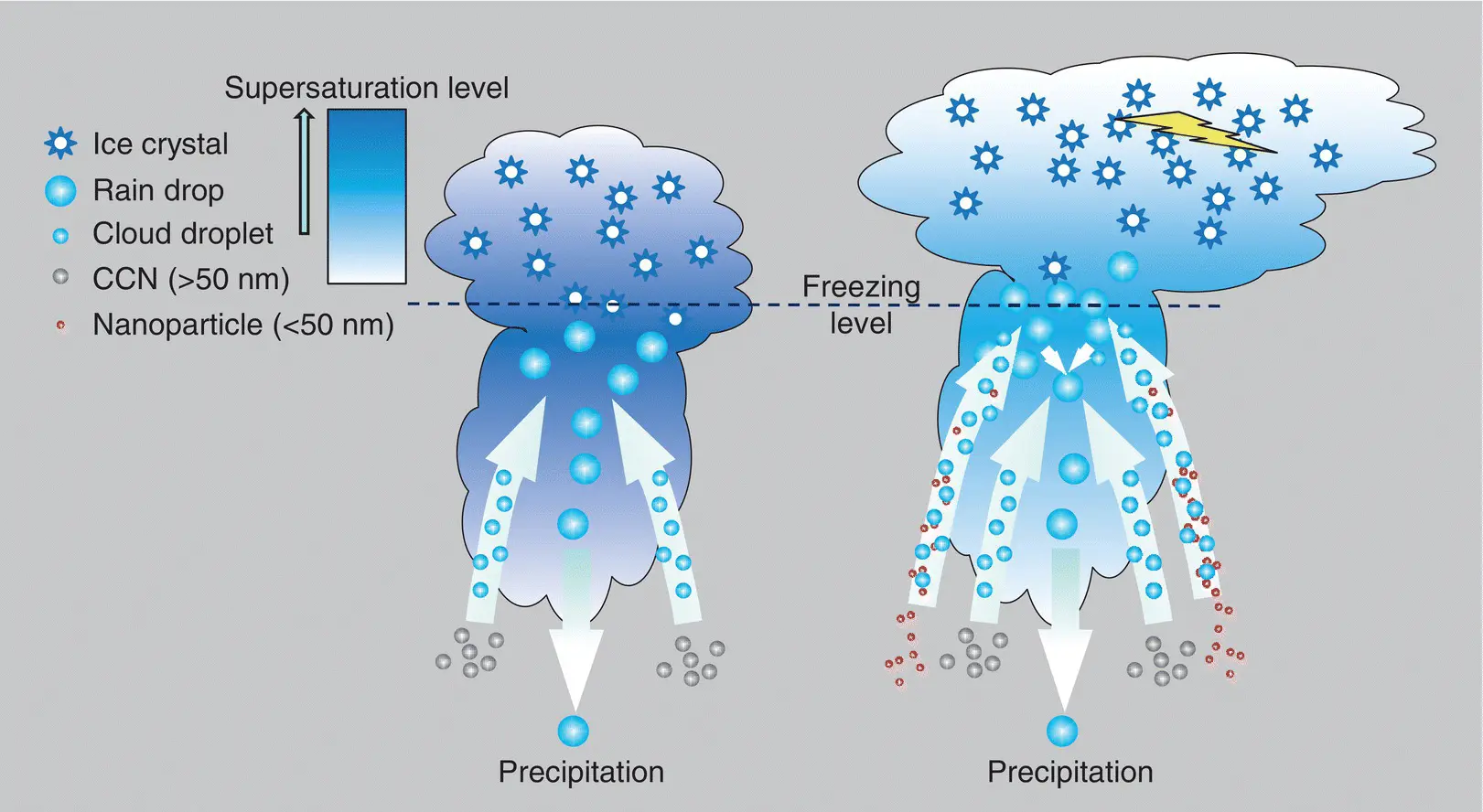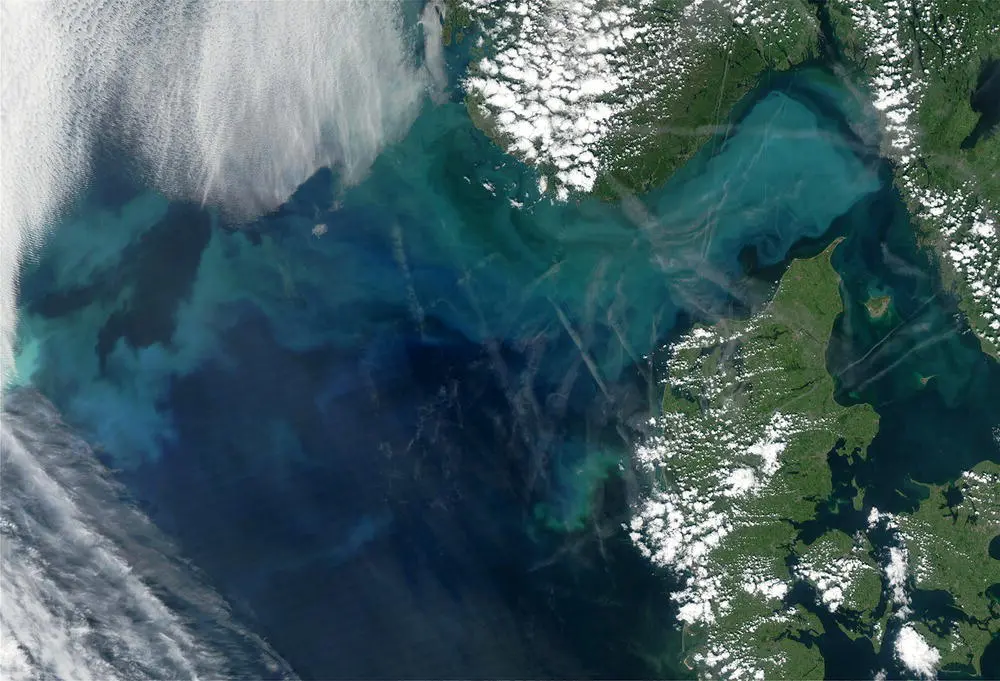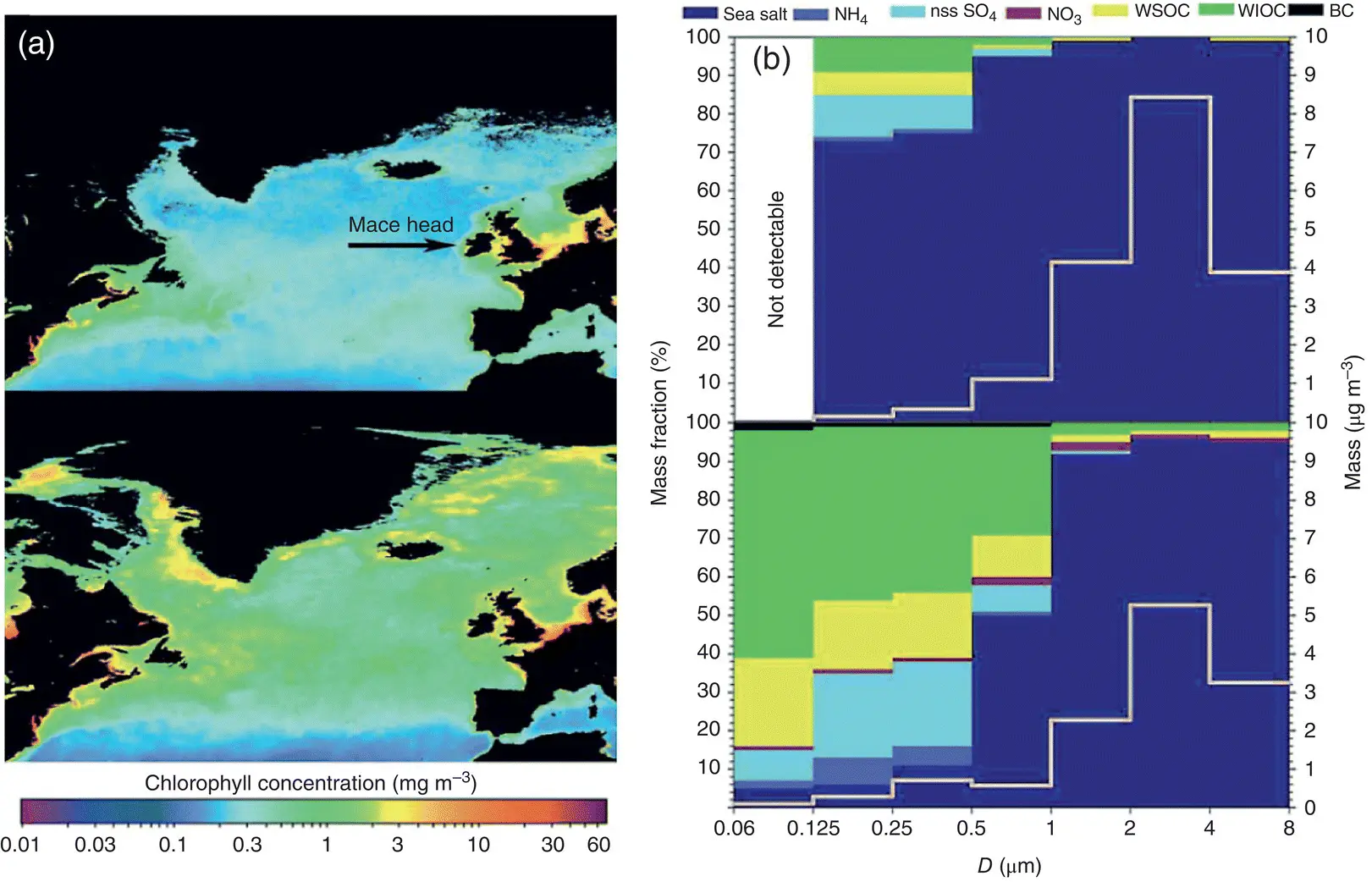Recently an experiment conducted in cloud formation above the Amazon rain forest provided new insight into the role of nanoparticles with sizes below 50 nm [16]. Large areas of the sky above the pristine rain forest have very low densities of aerosol particles, often measuring hundreds per cubic centimeter, which is similar to densities in preindustrial times. Within this environment lies the city of Manaus with 1.8 million inhabitants, which is a significant source of atmospheric nanoparticles with sizes below 50 nm that are carried in a plume by the North‐Easterly trade winds. Thus it was possible for the first time to isolate the effect of nanoparticles injected into preformed clouds.

Figure 2.10 Effect of nanoparticles on DCCs.In clouds that lack nanoparticles with sizes below 50 nm (UAP < 50) (left), the clouds are highly supersaturated above the cloud base with relatively few cloud droplets at high altitudes. With added UAP < 50 (right, red dots), an additional number of cloud droplets are nucleated above the cloud base, which enhances condensation, releasing additional latent heat at low and middle levels, thus intensifying convection, which drives more CCNs to higher altitudes. This increases the intensity of precipitation and electrification.
In particular, the study looked at the characteristics of deep convective clouds (DCCs) that are responsible for storms. Generally, these form in moist air when an atmospheric instability has initiated rising air that carries the moisture up into cooler air to form a supersaturated vapor. This will then condense into droplets in the presence of CCNs and the process releases latent heat into the surrounding air that increases the updraft driving more moisture into supersaturation. In very clean environments, in which CCNs are virtually absent at high altitudes, the process is self‐limiting. The effect of introducing nanoparticles into this situation was found to intensify the storm by the process illustrated in Figure 2.10. With the absence of the nanoparticles and a low density of larger CCNs, at high altitudes, the cloud droplets tend to remain at lower altitudes and form warm rain that reduces the droplet area available for condensation. Above the cloud base there is a very high level of supersaturation and injecting large numbers of nanoparticles with diameters less than 50 nm (UAP < 50) into this situation produces a significant increase in cloud droplets above the cloud base. The enhanced condensation generates latent heat that drives an updraft that carries larger CCNs to high altitudes and increases condensation and energy release, which further increases convection. This drives the cloud to higher altitudes, increases precipitation, and enhances storm electrification. Thus, the study showed that nanoparticles generated by human activity can significantly increase the intensity of storms in the tropics and this is important data to be fed into climate change models.
A significant proportion of atmospheric nanoparticles are generated above the oceans. These are known as Marine Aerosol and are produced by a number of sources. The simplest to understand are sea‐salt particles, which are produced when bursting bubbles at the surface produce a spray of droplets of brine from which the water evaporates to leave salt particles. These have a wide size range but all are small enough to form an aerosol and as with most aerosols, when measured as the number of particles per unit volume, the nanoparticles dominate with most particles having sizes around 30 nm [17]. Bearing in mind how slowly these falls out due to gravity they are easily carried into all levels of the atmosphere by winds and updrafts and a significant proportion of the aerosol over land is sea‐salt particles.
The story of Marine Aerosol becomes much more complicated when life is included since plankton and microorganism on the ocean surface, enable other mechanisms for producing particles. A common example starts with the chemical dimethyl sulfide (DMS), which is produced by phytoplankton 3 and released to the atmosphere above the oceans. Phytoplankton is the collective name for the many types of microscopic plants, coming in a variety of shapes that dwell just below the ocean surface. Their name is derived from the Greek phyton or “plant” and plagty or “drifter” and they are sometimes referred to as the “grasses of the sea.” They are similar to land‐based plants, containing chlorophyll, and using sunlight for photosynthesis, which is why they are found close to the surface. Their prevalence is revealed by satellite images such as the one shown in Figure 2.11from NASA's terra satellite. Huge turquoise colored regions reveal the presence of blooming phytoplankton. The DMS released by the plankton emerges from the sea and oxidizes in the atmosphere. The resulting compounds condense into sulfur‐containing nanoparticles that are carried high into the atmosphere.

Figure 2.11 Phytoplankton bloom in the North Sea.Clouds of phytoplankton are the turquoise colored patches in this image acquired on 27 June 2003 by the MODIS instrument on NASA's terra satellite. The landmass at the top right is Norway and Denmark is on the bottom right. Phytoplankton grows in nutrient‐rich waters, and multiplies very quickly; blooms big enough to be seen from space, like this one, can take only days to appear. Also visible are a number of streaky aircraft contrails.
Source : Image reproduced courtesy of NASA ( http://visibleearth.nasa.gov).

Figure 2.12 Composition of particles produced by phytoplankton.(a) Seasonal average over five years of sea‐surface chlorophyll concentrations in winter (top image) and spring (bottom image) obtained by the Sea‐viewing Wide Field‐of‐view Sensor (SeaWiFS) instrument in low earth orbit. The seasonal difference in biological activity is clear. The location of Mace Head where the aerosol composition was measured is shown in the top image. (b) Composition of aerosol in different size ranges. The region from 0.06 to 0.125 μm (60–125 nm) shows the nanoparticle abundance. In winter they are undetectable but during phytoplankton blooms they are abundant. The data is given for the different particle types: Sea salt (produced by the bubble‐bursting mechanism), NH4, non‐sea‐salt (NSS) SO 4, NO 3, water‐soluble organic carbon (WSOC) and water‐insoluble organic carbon (WIOC).
Source : Reproduced with the permission of the Nature Publishing Group from C. O'Dowd et al. [18].
A study of marine aerosol, generated above the North Atlantic and arriving at Mace Head on the West coast of Ireland, quantified the organic (life‐produced) and inorganic contributions to the marine aerosol in different seasons [18]. A marked difference was found between periods of high biological activity (plankton blooms) in the summer and periods of low biological activity in the winter. Figure 2.12a shows the level of chlorophyll across the Atlantic in summer and winter with (appropriately) green representing high chlorophyll levels. Notice how the summer bloom lights up the whole North Atlantic – an event of enormous scale. The bar graphs in Figure 2.12b show the composition of the marine aerosol during the two periods separated into different types of particle in different size ranges. The first bar covering the size range 0.06–0.125 μm (60–125 nm) shows the nanoparticle abundance. In winter these are undetectable when measured as a mass fraction (though they would still dominate if measured as a number density) and the entire diagram is dominated by sea‐salt particles. During the summer periods, water‐soluble, and water‐insoluble organic nanoparticles generated by phytoplankton are prolific.
Читать дальше















